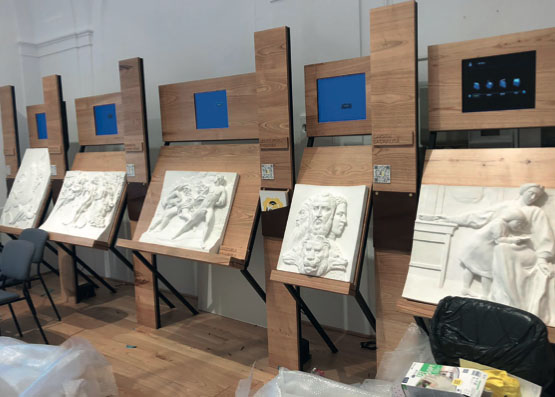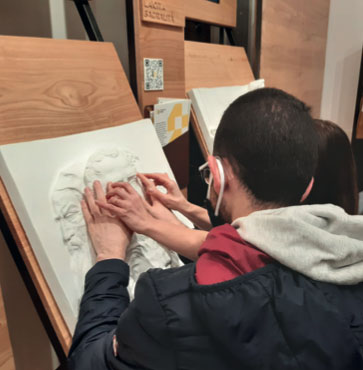On October 23, 2021, at the former Convent of San Francesco, in the city of Cava de’ Tirreni in the province of Salerno, was founded a multi-sensory museum named Eidos, thanks to the Sinapsi Foundation, in collaboration with the Institute for the Blind Francesco Cavazza. Eidos (εἶδος) is a Greek word meaning “form” or more properly “appearance,” a term from which derives the Greek εἴδωλον (éidõlon) which translates into “idol”, in the semantic meaning of “simulacrum”, or “figure.” The term became significant in Greek philosophy when Plato used it in reference to ideal forms in his theory of ideas.

Here we must understand the Platonic idea not as a “concept” but as a “form and content.” In fact, the Greek philosopher used indifferently the terms idea, eidos and ousìa to indicate the common form of all concepts. It was deemed appropriate to give this museum such a name, inhabited by coherently significant forms to highlight the inseparable relationship that exists between form and substance in a work of art, and more broadly in life. The Eidos Museum was created to educate the community in the development of sensory perception and intellectual development in all ages and conditions. Housed in a historic religious building, this space overlooks the surrounding nature and has a privileged access to the spirituality of the location because of a monastic cloister. The educational objectives of the Eidos Museum consist in enabling an overall sensitivity of the human being in contexts of life that can, by nature and condition, deprive and, by will and compensation, restore completeness of feeling. The privileged recipients of educational services in the program are in fact people with sensory, motor, and cognitive disabilities. But in reality, this place can only be for everyone, even if oriented by vocation to children and youth with specific needs, in line with the mission of the Sinapsi Foundation, of which this museum is an off-shoot. To this end, the proposed teaching units are adapted to the educational needs of individual class groups, even in respect of ministerial programs related to the specific goals of schools of all levels.

The art collection is set up on thematic criteria, through the adoption of dyads: pairs of opposite and mutually complementary principles. Topics such as Sacredness and Secularity; Emotion and Expression, Stagnation and Dynamism, Evidence and Dissolution; Permanence and Impermanence, Masculinity and Femininity, will lead the visitor along an introspective journey destined to involve body and mind in experiences of immersive fruition of the artistic heritage, documented here through translations and replicas of famous pictorial and sculptural masterpieces of human culture. The Eidos Museum, although limited in the number of works on display, is a reality that, strongly rooted in its territory, wants to open to cultures of all backgrounds, especially through the practice of experiential workshops aimed at educating children, teens and adults, the knowledge of reality and representation. A flower terrace complements the collection, with the presence of plants that can be traced back to the plant iconography present in the museum’s works, and allows for an understanding of natural cycles, through care and observation. With an immersive and direct experience, the visitor is led, through the development of sensory perception, to the value of practice for a theory of knowledge. The Eidos Museum is located in a small but cleverly arranged space, in accordance with functional and proven principles of museum accessibility. We should not forget how much the Eidos Museum has borrowed the didactic methodology from the Anteros Museum. Within it, content is offered to the sighted, blind, and visually impaired, respectively: in Latin characters, in braille alphabet and in enlarged black writing, on paper support; and digitally using QR codes.
Monitors are placed on the exhibition stations display images, audio, and video in LIS, designed for Deaf people. The Eidos Museum aims to make the entire community reflect on the semblance, inviting it to grasp the essence of the cycles of life: between theory and practice.

.jpg)



.png)